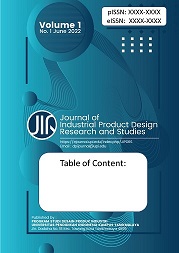Albasia Wood Waste as an Environmental-Friendly Cutlery Material
Abstract
Albasia is a type of softwood that is easily found in India, South China and Southeast Asia. In Indonesia itself albasia has been spread in various regions so it is very easy to find. The existence of albasia around the community is often considered not important and not useful even used as firewood, but this albasia is able to prevent erosion and this plant is also easily bred. In addition, albasia has an external substance that is able to protect from termite attacks so it is good to use as raw material for making furniture. This qualitative research aims to use albasia wood waste into environmentally friendly cutlery. As we know, cutlery is a thing that is much sought after either by parents who are already married, or by young people. With this research we can find out that albasia is very beneficial for the community and can be a source of livelihood for them. A lot of albasia wood waste is not only used as firewood, but can be used and made into something more valuable and also useful in the future. With this research, the idea came up to make plates made from albasia wood waste that is found in the streets and in rural areas with very large populations and certainly not utilized to the maximum.
Full Text:
PDFReferences
Bogoriani, N. W. (2010). Ekstraksi zat warna alami campuran biji pinang, daun sirih, gambir dan pengaruh penambahan KMnO4 terhadap pewarnaan kayu jenis albasia. Jurnal Kimia, 4(2), 125-134.
Fachrurrozie, F., Wahyudin, A., Widiyanto, W., Nurkhin, A., and Feriady, M. (2021). Peningkatan keterampilan santripreneur melalui pelatihan olah limbah kayu menjadi produk yang bernilai ekonomis. Jurnal Pengabdian Al-Ikhlas Unive, 7(2), 224-234.
Hutasuhut, A. R. (2019). Studi literatur meningkatkan kemampuan berpikir kreatif dengan pendekatan PMR matematis siswa. Journal of Mathematics Teacher Education, 1, 1-9.
Khairuzani, H. (2022). The existence of albasia plants in Cikaramas village: A case study of albasia cultivation in Cikaramas Village, Sumedang Regency, West Java. Journal of Science Innovare, 5(2), 34-39.
Musfiroh, H. (2020). Kajian komparatif perancangan dan produksi peralatan saji (Studi kasus CV Estetika Indonesia). Productum: Jurnal Desain Produk (Pengetahuan Dan Perancangan Produk), 3(8), 261–268.
Patil, H. N., & Sinhal, P. (2018). A study on edible cutlery: An alternative for conventional ones. Atithya: A Journal of Hospitality, 4(1), 45-51.
Purwanto, D. (2009). Analisa jenis limbah kayu pada industri pengolahan kayu di Kalimantan Selatan. Jurnal Riset Industri Hasil Hutan, 1(1), 14.
Wulandari, A. (2012). Pengaruh orientasi pelanggan, orientasi pesaing dan inovasi produk terhadap kinerja pemasaran. Management Analysis Journal, 1(2), 19-21.
DOI: https://doi.org/10.17509/jipdrs.v1i1.47471
Refbacks
- There are currently no refbacks.
Copyright (c) 2022 Universitas Pendidikan Indonesia (UPI)

This work is licensed under a Creative Commons Attribution-ShareAlike 4.0 International License.

This work is licensed under a Creative Commons Attribution-ShareAlike 4.0 International License.


